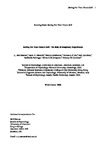Saving for your future self: The role of imaginary experiences
| dc.contributor.author | Macrae, CN | |
| dc.contributor.author | Mitchell, JP | |
| dc.contributor.author | Golubickis, Marius | |
| dc.contributor.author | Ho, Nerissa | |
| dc.contributor.author | Sherlock, R | |
| dc.contributor.author | Parlongo, R | |
| dc.contributor.author | Simpson, OCM | |
| dc.contributor.author | Christian, BM | |
| dc.date.accessioned | 2020-04-07T10:46:45Z | |
| dc.date.available | 2020-04-07T10:46:45Z | |
| dc.date.issued | 2017-07-04 | |
| dc.identifier.issn | 1529-8868 | |
| dc.identifier.issn | 1529-8876 | |
| dc.identifier.uri | http://hdl.handle.net/10026.1/15526 | |
| dc.description.abstract |
Despite increased longevity, many people fail to save the funds necessary to support their retirement. In an attempt both to elucidate and remedy this failing, research exploring the “future-self continuity” hypothesis has revealed that temporal discounting is decreased and saving increased when connections between one’s current and future self are strengthened. Here, we explored the possibility that a basic component of mental imagery–spatial visual perspective–may be an important determinant of people’s decisions to spend now or save for the future. The results of two experiments supported this prediction. Rates of saving were enhanced when a distant-future event was generated from a third-person vs. first-person vantage point, an effect that was mediated by visual bodily awareness during mental imagery. | |
| dc.format.extent | 384-398 | |
| dc.language | en | |
| dc.language.iso | en | |
| dc.publisher | Informa UK Limited | |
| dc.subject | Self | |
| dc.subject | prospection | |
| dc.subject | mental imagery | |
| dc.subject | visual perspective | |
| dc.subject | intertemporal choice | |
| dc.title | Saving for your future self: The role of imaginary experiences | |
| dc.type | journal-article | |
| dc.type | Journal Article | |
| plymouth.author-url | https://www.webofscience.com/api/gateway?GWVersion=2&SrcApp=PARTNER_APP&SrcAuth=LinksAMR&KeyUT=WOS:000396844600002&DestLinkType=FullRecord&DestApp=ALL_WOS&UsrCustomerID=11bb513d99f797142bcfeffcc58ea008 | |
| plymouth.issue | 4 | |
| plymouth.volume | 16 | |
| plymouth.publication-status | Published | |
| plymouth.journal | Self and Identity | |
| dc.identifier.doi | 10.1080/15298868.2016.1264465 | |
| plymouth.organisational-group | /Plymouth | |
| plymouth.organisational-group | /Plymouth/Faculty of Health | |
| plymouth.organisational-group | /Plymouth/Faculty of Health/School of Psychology | |
| plymouth.organisational-group | /Plymouth/REF 2021 Researchers by UoA | |
| plymouth.organisational-group | /Plymouth/REF 2021 Researchers by UoA/UoA04 Psychology, Psychiatry and Neuroscience | |
| plymouth.organisational-group | /Plymouth/REF 2021 Researchers by UoA/UoA04 Psychology, Psychiatry and Neuroscience/UoA04 Psychology, Psychiatry and Neuroscience MANUAL | |
| plymouth.organisational-group | /Plymouth/Users by role | |
| plymouth.organisational-group | /Plymouth/Users by role/Academics | |
| dc.identifier.eissn | 1529-8876 | |
| dc.rights.embargoperiod | Not known | |
| rioxxterms.versionofrecord | 10.1080/15298868.2016.1264465 | |
| rioxxterms.licenseref.uri | http://www.rioxx.net/licenses/all-rights-reserved | |
| rioxxterms.type | Journal Article/Review |


